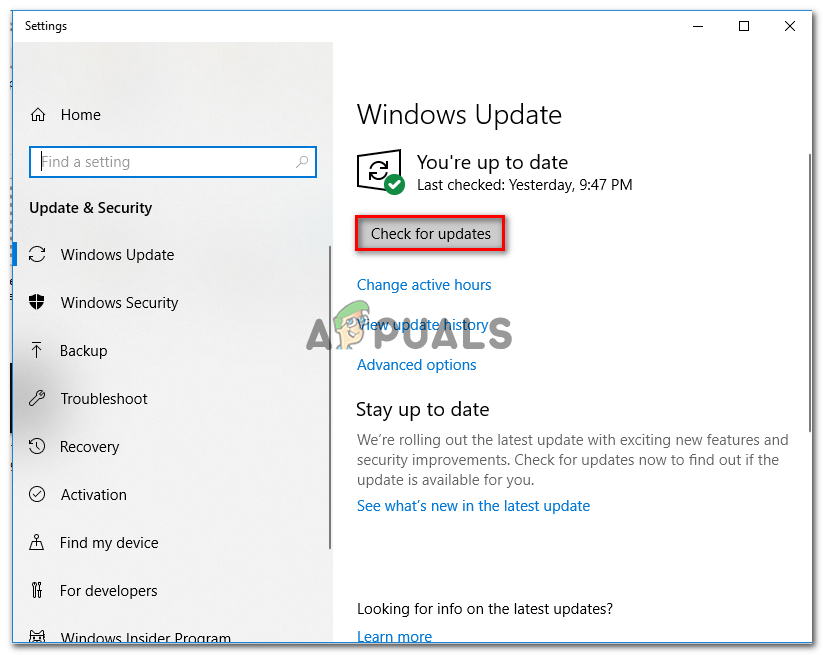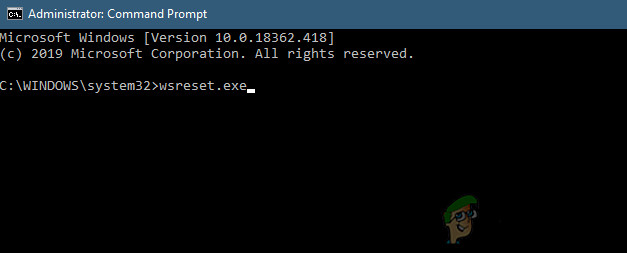After investigating this issue, it turns out that there are several different underlying causes that are known to produce this error code. Here’s a list of methods that are known to cause this error code on Windows 10: Now that you are intimately familiar with every method that has the potential of causing this particular error code, here’s a list of methods that other affected users have successfully used to resolve this issue:
Method 1: Installing the Windows 10 Hotfix (if applicable)
If you started experiencing this issue immediately after you updated your Windows 10 version to build 18362.86 (or you suspect this might be the main cause of the issue ) you should start this troubleshooting guide by installing the hotfix that Microsoft has released for this particular issue. Some users that were dealing with the same issue have confirmed that no new instances of the ESENT Errors have been created inside the Event Viewer after they installed every pending Windows 10 update and restarted their computer. If you’re looking for specific instructions on how to install the hotfix on Windows 10, follow the steps below to use the Windows Update tab inside the Settings app to install every pending Windows 10 update: In case the same kind of issue is still occurring, move down to the next potential fix below.
Method 2: Complete the Corrected Path
As it turns out, in most documented instances you’ll encounter this issue due to a bad path that doesn’t exist in reality. if you don’t want to resolve this issue by utilizing a more comprehensive cleansing tool, one non-damaging operation would be to manually create the path expected by your OS as per the error displayed by Event Viewer. If you want to give this potential fix a try, go ahead and look at the error inside Event Viewer and see if there’s some kind of mention of a broken location. Something like: C:\WINDOWS\system32\config\systemprofile\AppData\Local\TileDataLayer\Database\EDB.log. Once you manage to locate the location that is signaled out by the Event Error, open File Explorer and try to naturally navigate through the location. If any folders are missing from the list, correct the path and create a blank file so the scan can reach it. After you do so, restart your computer and see if new instances of the same kind of ESENT 490 errors are still appearing. Additionally, you can do this directly from an elevated CMD prompt: If the issue is still not resolved and you’re still seeing new Event Viewer entrances related to ESENT 490, move down to the next potential fix below.
Method 3: Performing CHKDSK, SFC, and DISM scans
Since this issue is most likely related to some kind of system file corruption, your next attempt at fixing the ESENT 490 should be by running a couple of utilities that are designed to tackle corrupted Windows files. Fortunately, every recent Windows version is equipped with CHKDSK (Check Disk utility) ( SFC (System File Checker) and DISM (Deployment Image Servicing and Management). Our recommendation is to run all three utilities in quick succession (as per the instructions below) via the Recovery Menu in order to maximize your chances of fixing the corrupted files without having to clean install your Windows installation. Follow the step-by-step instructions below for instructions on how to In case you boot back up and you see the same kind of ESENT errors inside the Event Viewer utility, move down to the next potential fix below.
Method 4: Resetting every Windows Update & Windows Store
According to some affected users, you can expect to see this issue occurring due to some type of system file corruption that is affecting either Windows Update or Windows Firewall and ends up creating a lot of different listings inside Event Viewer. As it turns out, most of these occurrences are created because one of the services mentioned above is stuck in a limbo state (they’re neither opened nor closed). If this scenario is applicable you should be able to fix the issue swiftly either by resetting Windows Update or Windows Store, depending on the program that is causing this problem. Since there is no way of checking which component is causing this issue, our recommendation is to reset both in order to eliminate 2 potential culprits of the list. Follow the first sub-guide below and then the next one after to reset both Windows Update and Windows Store on your Windows 10 operating system:
A. Resetting Windows Store
B. Resetting Windows Update
Once every relevant service has been restarted, repeat the WU action that was previously triggering the Event Errors and see if the new events have stopped occurring.
Method 5: Reset every Windows Component
In case none of the methods above have allowed you to stop the apparition of new instances of the ESENT 490 event errors, you should seriously take into consideration that you might be dealing a case of system file corruption. If you find yourself in a scenario like this, the only thing you can do at this point is to reset every relevant Windows component and eliminate every potentially corrupted element – When it comes to doing this, you have two ways forward:
Clean Install – Use this method if you’re looking for a quick fix that can be deployed without the need of using compatible Windows installation media. You can deploy a clean install procedure directly from the GUI menu of your Windows installation. However, unless you back up your data in advance, you will lose any personal data that’s currently stored on the OS drive.Repair Install – If you have any important information on the OS drive that you plan on keeping, a repair install should be the way to go for you, even if the procedure is a bit tedious. You are forced to use compatible installation media, but you will be able to keep your personal files, installed applications, games, and even some user preferences rooted on the OS drive.
Fix: Event ID 455 ESENT Error in Windows 10 1903Microsoft Accepts Windows 10 ‘ESENT’ Warning Error Message Bug After v2004 20H1…Fix Windows Update Error 0XC19001E2 in Windows 10 (Fix)FIX: Windows Defender Error The service couldn’t be started Error code:…










